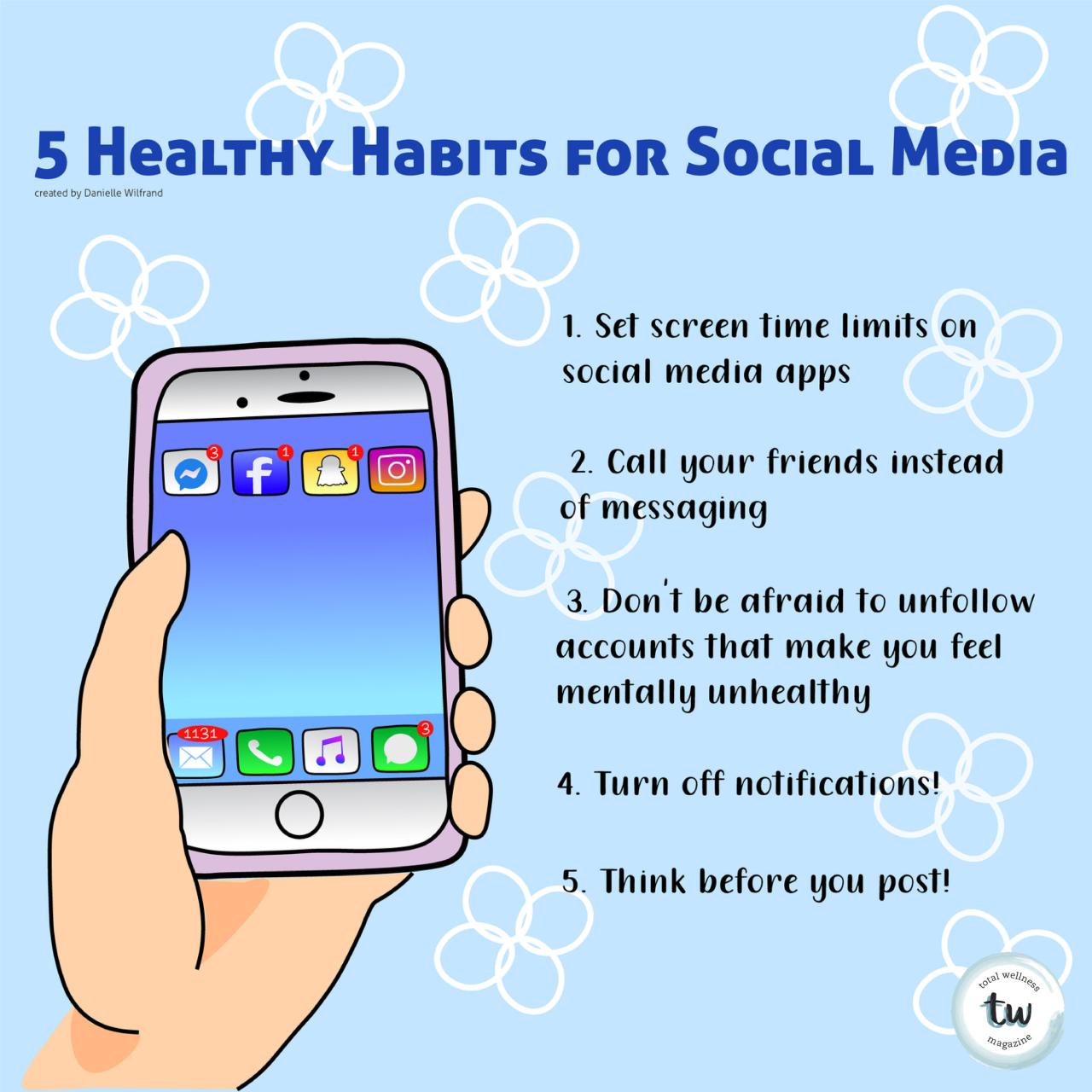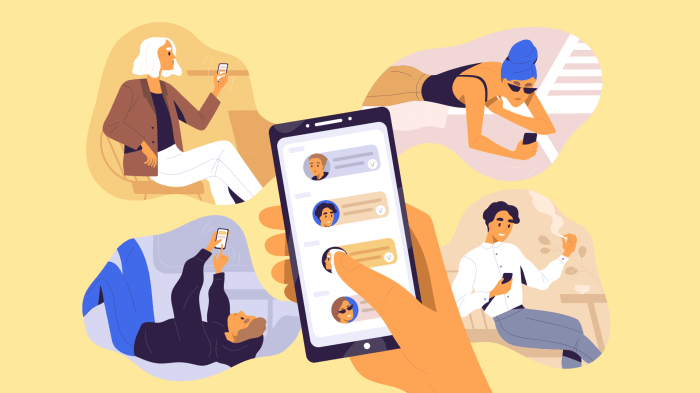Social media habits are all the rage these days, from scrolling through endless feeds to posting the perfect selfie. Get ready to explore the world of online behavior in a way that’s as cool as your favorite high school hangout spot.
From age groups to mental health impacts, this topic covers it all with a fresh perspective that will keep you hooked.
Social Media Usage Patterns: Social Media Habits

In today’s digital age, social media has become an integral part of our daily lives, impacting people of all age groups in various ways. Let’s take a closer look at the common social media habits among different age groups and how they vary based on weekdays versus weekends, as well as the impact of these habits on mental health.
Age Group Differences
- Teenagers and young adults are often heavy users of social media platforms like Instagram, Snapchat, and TikTok, spending several hours a day scrolling through feeds, posting updates, and engaging with others.
- Adults, especially those in the workforce, tend to use social media more for networking purposes, connecting with colleagues, and staying updated on industry news.
- Seniors are increasingly joining social media platforms to stay connected with family members, share photos, and engage in online communities.
Weekdays vs. Weekends
- During weekdays, social media usage tends to peak in the early morning, lunchtime, and evening hours as people check their feeds during breaks or after work.
- On weekends, there is a shift towards more leisurely browsing, with users spending longer periods online, watching videos, shopping, and interacting with friends and family.
- Weekends also see an increase in social media usage for entertainment purposes, such as streaming live events, following influencers, and participating in online challenges.
Impact on Mental Health
- Excessive use of social media has been linked to feelings of anxiety, depression, and loneliness, as constant comparison with others’ curated online lives can lead to negative self-perception.
- On the flip side, social media can also provide a sense of community, support, and connection, especially for individuals who may feel isolated or marginalized in their offline lives.
- It is essential for users to strike a balance between online and offline activities, setting boundaries, and being mindful of how social media consumption affects their mental well-being.
Types of Social Media Platforms

In the world of social media, different platforms cater to various types of content and interactions. Let’s take a closer look at how user habits differ across different types of social media platforms.
Visual Platforms like Instagram vs. Text-based Platforms like Twitter
Visual platforms like Instagram focus on sharing photos and videos, allowing users to express themselves through visual content. Users on Instagram tend to engage more with aesthetically pleasing posts, often focusing on lifestyle, fashion, and travel. On the other hand, text-based platforms like Twitter prioritize short and concise messages, making it easier for users to share thoughts, news, and updates in real-time. Twitter users often engage in discussions, debates, and trending topics through tweets and retweets.
Professional Platforms like LinkedIn vs. Casual Platforms like Snapchat
Professional platforms like LinkedIn are geared towards networking, job searching, and industry-related content. Users on LinkedIn maintain a professional profile, connecting with colleagues, recruiters, and industry professionals. The content shared on LinkedIn is often related to career achievements, industry insights, and professional development. In contrast, casual platforms like Snapchat focus on ephemeral content, such as disappearing photos and videos. Users on Snapchat engage in casual conversations, sharing moments from their daily lives, and using fun filters and stickers to enhance their posts.
Influence of Social Media Platform Design on User Habits
Social media platform design plays a crucial role in shaping user habits and interactions. The layout, features, and algorithms of a platform can impact how users engage with content, connect with others, and spend their time on the platform. For example, platforms with infinite scrolling may encourage users to spend more time browsing through posts, while platforms with chronological feeds may prioritize recent content. Additionally, features like stories, hashtags, and live videos can influence how users create and consume content on social media platforms.
Social Media Posting Behavior
In the world of social media, posting behavior plays a crucial role in determining engagement levels and overall reach. Understanding how often people post, the type of content they share, and the timing of their posts can significantly impact their online presence and interactions.
Frequency of Posting and Engagement
When it comes to social media, the frequency of posting can directly influence engagement levels. People who post regularly tend to have a more active and engaged audience compared to those who post sporadically. Consistency is key when it comes to maintaining a connection with followers and building a loyal community.
- Posting multiple times a day can keep your audience engaged and interested in your content.
- However, overposting can lead to follower fatigue and a decrease in engagement, so finding the right balance is crucial.
- Posting at peak times when your audience is most active can help maximize engagement and reach.
Types of Content on Different Platforms
The type of content people tend to post varies across different social media platforms. Each platform has its own unique audience and purpose, which influences the kind of content that performs best.
- Instagram is known for visual content such as photos and videos, making it ideal for showcasing products or lifestyle content.
- Twitter is popular for short, concise updates and sharing news or trending topics in real-time.
- LinkedIn is focused on professional networking and career-related content, such as job postings and industry insights.
Psychology Behind Timing of Social Media Posts
The timing of social media posts can impact their visibility and engagement levels. Understanding the psychology behind when to post can help optimize reach and interaction with your audience.
- Posting during peak hours when your target audience is most active can increase the likelihood of your content being seen and shared.
- Considering time zones and the daily routines of your followers can help you determine the best times to post for maximum impact.
- Experimenting with different posting times and analyzing data on engagement can provide insights into when your audience is most receptive to your content.
Social Media Interaction
Social media habits play a significant role in shaping our online interactions with friends and family. The way we engage with social media platforms, the content we consume, and the frequency of our interactions all impact how we communicate with our loved ones in the digital space.
Echo Chambers
Echo chambers are online environments where individuals are primarily exposed to information that aligns with their existing beliefs and opinions. Social media habits contribute to the formation of echo chambers by algorithms that prioritize content based on user preferences. This can lead to a limited and skewed perspective on various issues, as individuals are less likely to be exposed to diverse viewpoints.
- Social media users may unknowingly reinforce their own beliefs by interacting mainly with like-minded individuals and consuming content that confirms their biases.
- Echo chambers can hinder meaningful discussions and debates, as opposing viewpoints are often silenced or excluded from the online conversation.
- Breaking out of echo chambers requires conscious effort to seek out diverse sources of information and engage with individuals who hold different perspectives.
Impact on Political Discourse, Social media habits
Social media habits have a profound impact on political discourse by influencing how individuals consume and engage with political content online. The way users interact with political posts, share information, and participate in discussions can either promote healthy debate or contribute to polarization and misinformation.
- Users may be exposed to biased or misleading information through their social media feeds, affecting their understanding of political issues and events.
- The echo chamber effect can intensify political polarization, as individuals are more likely to interact with content that aligns with their own political beliefs.
- Social media platforms can amplify the spread of misinformation and fake news, leading to the dissemination of inaccurate information that can influence public opinion and decision-making.
